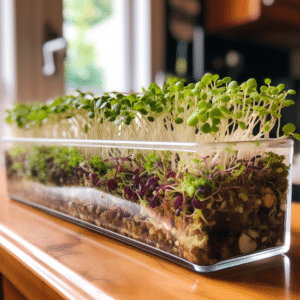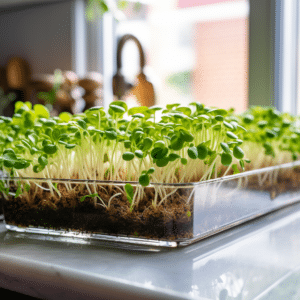Are you interested in growing your own nutritious sprouts at home? Sprouting is a simple and cost-effective way to enhance your diet with highly nutritious, fresh food all year round. This guide will walk you through the process of growing sprouts, from choosing the right seeds to harvesting your crop.
Understanding the Benefits of Sprouts

Sprouts are germinated seeds that are eaten raw or cooked. They are packed with essential nutrients and have numerous health benefits. Sprouts are rich in vitamins, minerals, proteins, and enzymes that can boost your immune system and improve your overall health.
Moreover, sprouts are easy to digest as the sprouting process breaks down the starches into simple sugars. They are also low in calories, making them a perfect addition to any weight loss diet. Furthermore, sprouts are an excellent source of dietary fiber, which aids in digestion and helps maintain a healthy gut.
Choosing the Right Seeds for Sprouting
There are many different types of seeds that can be sprouted, including beans, grains, and vegetable seeds. Some popular choices for sprouting include alfalfa, mung beans, lentils, radish, and broccoli. Each type of sprout has a unique flavor and nutritional profile, so it’s worth experimenting with a few different types to see which ones you prefer.
When choosing seeds for sprouting, it’s important to select high-quality, organic seeds that are intended for sprouting. These seeds are free from harmful chemicals and have a higher germination rate. Avoid seeds that are treated with fungicides or pesticides, as these chemicals can be harmful when ingested.
Materials Needed for Sprouting

One of the great things about sprouting is that it requires very few materials. Here’s what you’ll need:
- A glass jar
- A sprouting lid or cheesecloth
- Seeds for sprouting
- Water
You can find sprouting jars and lids online or at your local health food store. If you can’t find a sprouting lid, a piece of cheesecloth secured with a rubber band will work just as well.
Steps to Grow Sprouts at Home
Step 1: Soaking the Seeds
The first step in the sprouting process is to soak the seeds. This helps to soften the outer shell of the seed and kickstart the germination process. To soak your seeds, place them in your sprouting jar and cover them with plenty of water. The seeds will expand as they soak, so be sure to add enough water.
Let the seeds soak overnight, or for about 8-12 hours. After soaking, drain the water from the jar using the sprouting lid or cheesecloth. Rinse the seeds with fresh water and drain again.
Step 2: Rinsing and Draining

After the initial soak, you’ll need to rinse and drain the seeds twice a day. This helps to keep the seeds moist and prevents mold from forming. To rinse the seeds, simply fill the jar with water, swirl it around, and drain. Be sure to drain all the water, as standing water can cause the seeds to rot.
After rinsing and draining, place the jar in a bowl at an angle to allow any excess water to drain out. The jar should be placed in a location that is out of direct sunlight and has good air circulation.
Step 3: Harvesting the Sprouts
The time it takes for the seeds to sprout will depend on the type of seed, but most seeds will sprout within 3-7 days. You’ll know the sprouts are ready to harvest when they have grown to about 1-2 inches long and have a tiny leaf at the top.
Before eating the sprouts, give them a final rinse and drain. You can store the sprouts in the refrigerator for up to a week. Be sure to rinse the sprouts once a day to keep them fresh.
Conclusion
Growing sprouts at home is a simple and rewarding process. Not only do sprouts add a fresh, crunchy texture to your meals, but they also offer numerous health benefits. With just a few basic materials and a little bit of time, you can start growing your own sprouts today. Happy sprouting!
